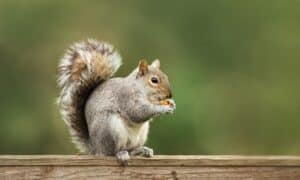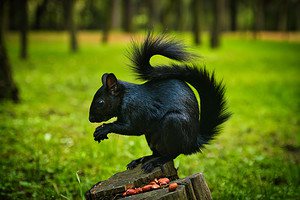Squirrels are small rodents with a full body and bushy tail. They are found worldwide and are very trusting animals that interact with humans often; people have even kept them as pets. Squirrels belong to the family Sciuridae, and while there are over 200 species of squirrel, they are mainly categorized into three types: ground squirrels, tree squirrels, and flying squirrels. Despite their difference in habitat, they all are very communicative. Squirrels have a variety of sounds that signify different meanings. This article will discuss three of their main sounds — screeching, snorting, and barking — and will dive into the details and world of the various squirrel sounds.

Native to the Pacific Northwest, Douglas squirrels inhabit coniferous and mixed forests throughout Washington, Oregon, and northern California.
©Randy Bjorklund/Shutterstock.com
Why Do Squirrels Make Screeching, Snorting, and Barking Sounds?
Squirrels are social creatures, and they are also very chatty. While they may not have a language like you and I, they have established a communication method. Squirrels emit a variety of noises, each with separate meanings. Some of the most common squirrel sounds you will hear are screeching, snorting, and barking. Squirrels make screeching, snorting, and barking sounds for various reasons. Those reasons include defending territory, raising the alarm, showing distress, scaring off predators, mating calls, and social interactions.
6 Reasons Squirrels Make Screeching, Snorting, and Barking Sounds
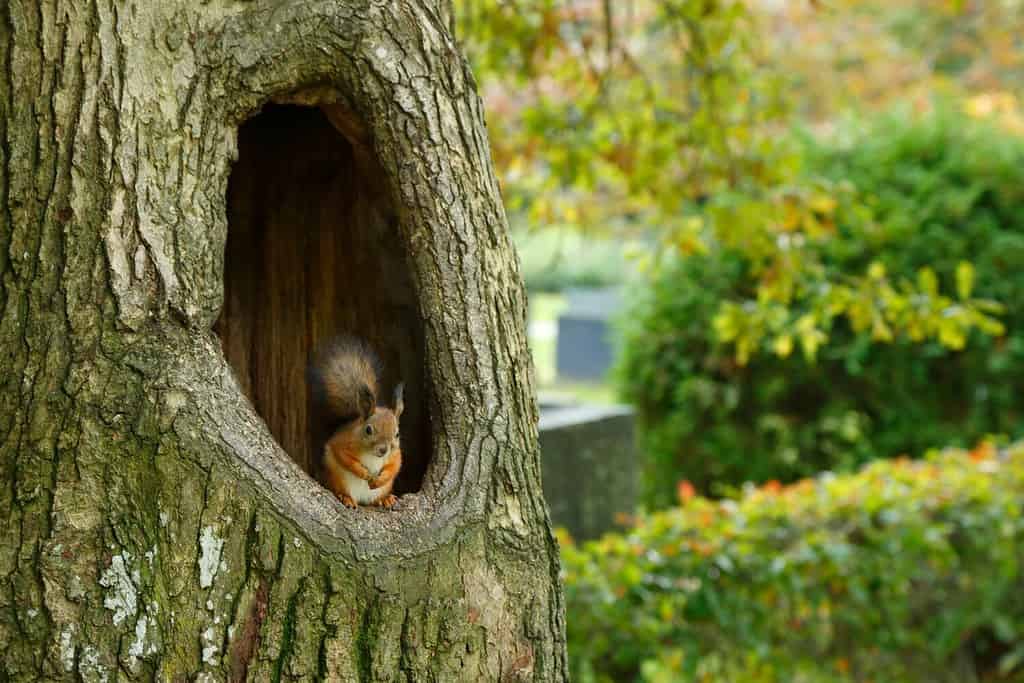
Squirrels usually nest on walnut, oak, pecan, hickory, maple, elm, and mulberry trees. A squirrel may screech to defend its territory.
©Antero Aaltonen/Shutterstock.com
1. Defending Territory and Food Sources
Squirrels often use a screeching sound to defend their territory and food source from other squirrels. During the winter, food is less plentiful, so the squirrel stores nuts, seeds, and other food items across different locations. They do this to ensure there is enough food for the harsher weather. If another squirrel encroaches on its territory, it will emit a short barking sound, letting that oncoming squirrel know they are trespassing.
Sometimes, this sound alerts the wandering squirrel of the barker squirrel’s presence; however, other times, it is a direct threat to that intruding squirrel and a clear indicator to leave the area immediately.
2. Raising the Alarm Bell
Squirrels will bark to warn other squirrels that a predator is near. Being so small, squirrels have a lot of predators to worry about, snakes, coyotes, and weasels being some of them. Squirrels have different types of barks that mean specific things. Dr. Robert S. Lishak discusses the difference between these barks, the “kuk” and the “quaa”. The main difference between these sounds is that the “kuk” is short and repeated several times, whereas the “quaa” is a more extended version of the “kuk”.
Additionally, squirrels have different barks to differentiate between different types of predators. For example, if a ground predator is nearby, the squirrel will make the “kuk” barking sound. However, if the predator is an aerial predator, the squirrel will make the “seet” and “bark” sounds.
3. Scare off Predators
Besides alerting fellow squirrels of danger, squirrels will also screech to scare off oncoming predators. This screech lets the predator know that the squirrel has seen it, and it no longer has the element of surprise. For some predators — like cats — that may be enough to deter them. However, if the screech alone is insufficient, squirrels can also scratch at the threat to protect themselves.
However, squirrels favor fleeing over fighting and will more likely than not evade the predator if it does not heed the screeching warning. Squirrels are very fast and often escape their predator by moving quickly from one location to the next.
4. They Are in Distress
Suppose a squirrel is injured or experiencing pain or distress. In that case, they may screech or scream to signal that discomfort to other squirrels. This squirrel sound allows them to tell the other squirrels they need aid while hopefully scaring off any predators that may have been the source of that discomfort, distress, or pain.
5. Social Interactions and Cues
Squirrels are social and chatty creatures, and they use barking to communicate with one another. The barks can establish dominance or hierarchy among a group. Squirrels also use this sound to resolve conflicts between two squirrels fighting over territory. It can even be used to express frustration when the squirrels encounter obstacles or challenges in their environment.
6. Mating
Although slightly different from the alarm sounds, the squirrel’s sound for mating can often be confused with a barking sound. This sound is called the “muk muk” sound, and the males make it to attract the female’s attention. This sound also establishes their presence and dominance over other potential mates.
Summary of Squirrel Sounds
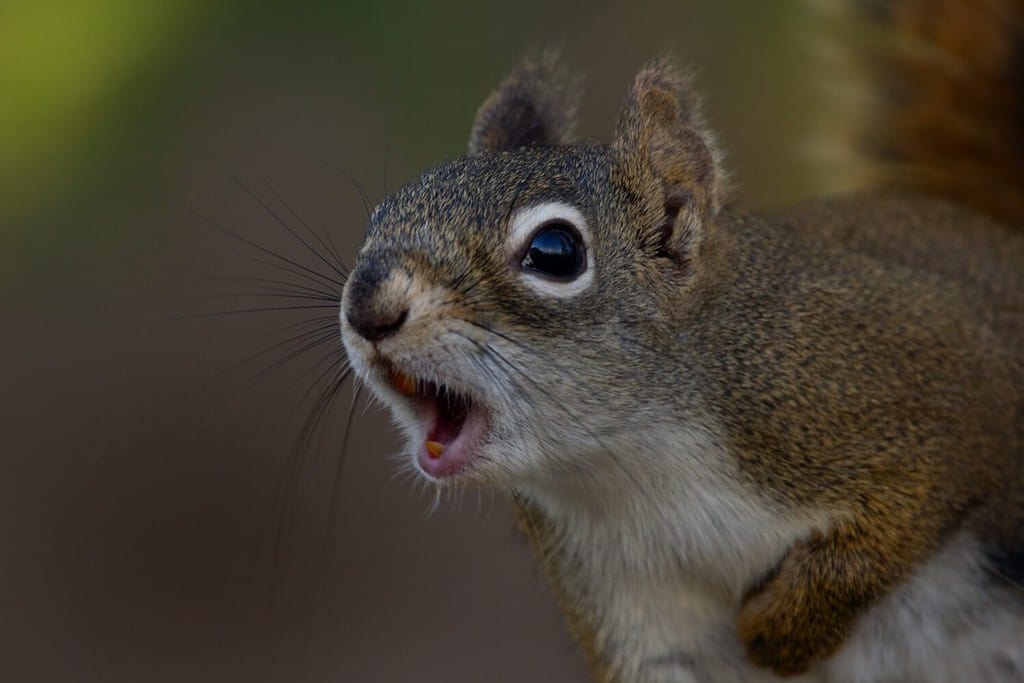
There are a variety of squirrel sounds, each with their own meaning. The screech can be used to defend territory and food sources and show distress.
©Saeedatun/Shutterstock.com
While squirrels make a more extensive variety of sounds than the ones presented in this article, the table below summarizes the three sounds we discussed and the reasons the squirrels would make them.
| Sound | Reason |
|---|---|
| Screeching | Defending territory and food sources Threatening another squirrel Showing dominance Showing distress |
| Barking | Alarm call to warn of a predator “Seet” bark sound for aerial predators To scare off a predator For mating purposes |
| Snorting | Used as an alarm |
5 Interesting Facts About Squirrels
Here are five interesting facts about these adorable rodents that do not center around the sounds that they make.
- Squirrel’s teeth never stop growing!
- Squirrels exist on every continent except Antarctica and Australia.
- There are more than 200 species of squirrels all over the world.
- White pepper, garlic, and black pepper are all smells that repel squirrels.
- Squirrels are rodents with a very trusting personality.
Other Animals That Make Screeching, Snorting, and Barking Sounds
Squirrels are not the only animals that make screeching, snorting, and barking sounds. Check out the section below to discover more animals that communicate with sounds similar to squirrel sounds.
Screech Owl

Screech owls are opportunistic feeders, consuming small mammals, birds, and insects.
©CC BY-SA 2.0 – License
These owls are nocturnal creatures that can be found across North America. These owls inhabit various environments, including woodlands, farm groves, and shade trees. Similar to squirrels, screech owls use diverse sounds to communicate. They use sharp barking calls to indicate their alarm or agitation at something, and — true to their name — these owls release screeches when defending their young or nests.
Badger
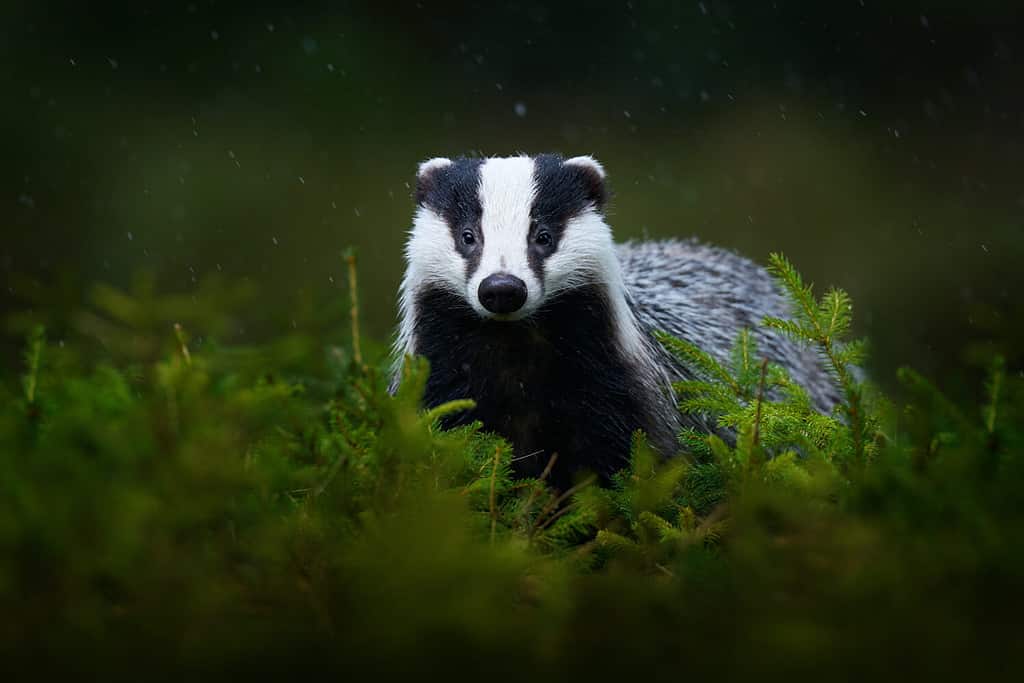
Badgers’ main habitats are grassland areas, mountain meadows, forest glades, and marshes.
©Ondrej Prosicky/Shutterstock.com
The badger is a medium-sized animal with a long, low body and elongated claws. Badgers live across North America, Europe, Japan, China, Indonesia, and Malaysia. Also, they have a wide array of communication sounds, just like squirrels. They make two sounds similar to the squirrel’s sounds: a bark and a snort. Like squirrels, you can hear the bark of the badger to signify surprise or as a warning or defense. However, badgers also bark during mating, when annoyed with one another, or even when playing. The snort of the badger usually indicates surprise or being startled by a fellow badger.
Sea Lion

Male sea lions often bark to defend their territory or attract a female mate.
©NatureDiver/Shutterstock.com
Sea lions live in various climates in both the northern and southern hemispheres. The Atlantic Ocean is the only major ocean without any sea lions. Weighing between 110-2,400 pounds, these mammals are an impressive sight to behold. Similar to squirrels, although there are a variety of sea lions, they are all great communicators. The sound that the sea lion shares with the squirrel is the bark. Sea lions bark mainly because a male defends territory, establishes dominance, or attracts a mate.
Common Questions

Squirrels primarily eat seeds, nuts, fungi, and fruit.
©Saeedatun/Shutterstock.com
How do I know if a squirrel has rabies?
The only way to be sure is to have the suspected squirrel brought to a lab and tested for rabies. However, strong indications of something wrong — or that the squirrel could be infected — include any abnormal behavior. If you see a squirrel acting very confused, lethargic, overly aggressive, or drooling from the mouth, these could all be indications of a rabies infection.
Where do squirrels go at night?
Most squirrel species are diurnal — meaning they are active during the day and sleep at night — but some species are nocturnal, so they would be hunting for their food at night. The three most common places squirrels go at night are in a tree nest to sleep, in a ground nest to sleep, or on the prowl for food.
Are squirrels friendly towards people?
Although you should always exercise caution when approaching or dealing with a wild animal, squirrels are a relatively friendly species. They are very trusting of humans and will often approach them for food. They even used to be a common choice of pet, although it is illegal in most states now.
What are squirrels good for?
Besides being adorable and entertaining to watch, there is another reason you should like these bushy-tailed rodents. They help plant new trees. While that may not be their intention, squirrels effectively bury seeds and nuts to store as a food source; they will occasionally forget where those seeds are and, in return, have planted a new tree.
The photo featured at the top of this post is © Saeedatun/Shutterstock.com
Thank you for reading! Have some feedback for us? Contact the AZ Animals editorial team.





